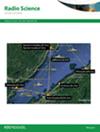High-performance compact elliptic fractal-plasmonic microstrip antenna for advanced wireless communication
IF 1.5
4区 地球科学
Q3 ASTRONOMY & ASTROPHYSICS
引用次数: 0
Abstract
Modern wireless communication standards require small, high-performing antennas, which are becoming increasingly necessary as technology develops. Simple geometries and traditional dielectric materials limit the bandwidth, efficiency, and flexibility of traditional microstrip antennas, which limits their use in high-frequency applications. This study proposes a novel Elliptic Fractal-Plasmonic Microstrip Antenna that integrates advanced materials and innovative geometries to improve bandwidth, efficiency, and miniaturization. The design includes a Rogers RT/DUROID 5880 lower substrate, aperture coupling with plasmonic effects, and a graphene-based ground plane with an H-slot for enhanced conductivity and flexibility. The upper substrate uses barium titanate to enable miniaturization, while the elliptically shaped patch with nested fractals and slots improves impedance matching and supports multiple resonant frequencies, expanding the operational bandwidth. The proposed model analysis shows outstanding results at terahertz frequencies, with a return loss of —34.4 dB at 10 THz, resonant frequencies of 13.06 THz, 11.65 THz, and 11.86 THz, and impedance bandwidths of 18.06 THz, 16 THz, and 16.5 THz. The input impedance remains stable, and Voltage Standing Wave Ratio values confirm excellent radiation characteristics. These results indicate a significant improvement in bandwidth, efficiency, and miniaturization compared to conventional designs.用于先进无线通信的高性能紧凑椭圆分形等离子体微带天线
现代无线通信标准需要小型、高性能的天线,随着技术的发展,这变得越来越必要。简单的几何形状和传统的介电材料限制了传统微带天线的带宽、效率和灵活性,这限制了它们在高频应用中的使用。本研究提出了一种新的椭圆分形等离子体微带天线,它集成了先进的材料和创新的几何形状,以提高带宽,效率和小型化。该设计包括Rogers RT/DUROID 5880下部衬底,具有等离子体效应的孔径耦合,以及具有h槽的石墨烯基接地面,以增强导电性和灵活性。上面的衬底采用钛酸钡实现小型化,而椭圆形状的贴片具有嵌套的分形和插槽,可以改善阻抗匹配并支持多个谐振频率,从而扩展了工作带宽。所提出的模型分析在太赫兹频率下效果显著,在10太赫兹频率下回波损耗为-34.4 dB,谐振频率为13.06 THz, 11.65 THz和11.86 THz,阻抗带宽为18.06 THz, 16 THz和16.5 THz。输入阻抗保持稳定,电压驻波比值证实了良好的辐射特性。这些结果表明,与传统设计相比,在带宽、效率和小型化方面有了显着改善。
本文章由计算机程序翻译,如有差异,请以英文原文为准。
求助全文
约1分钟内获得全文
求助全文
来源期刊

Radio Science
工程技术-地球化学与地球物理
CiteScore
3.30
自引率
12.50%
发文量
112
审稿时长
1 months
期刊介绍:
Radio Science (RDS) publishes original scientific contributions on radio-frequency electromagnetic-propagation and its applications. Contributions covering measurement, modelling, prediction and forecasting techniques pertinent to fields and waves - including antennas, signals and systems, the terrestrial and space environment and radio propagation problems in radio astronomy - are welcome. Contributions may address propagation through, interaction with, and remote sensing of structures, geophysical media, plasmas, and materials, as well as the application of radio frequency electromagnetic techniques to remote sensing of the Earth and other bodies in the solar system.
 求助内容:
求助内容: 应助结果提醒方式:
应助结果提醒方式:


